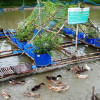Finding balance and peace with nature

The 16th Conference of Parties to the UN Convention on Biological Diversity (COP16) wrapped up on Saturday in Cali, Colombia. This was the first biodiversity COP since the adoption of the Kunming-Montreal Global Biodiversity Framework (GBF) at COP15 held in Montreal, Canada in December 2022. The parties (governments) and other stakeholders will review the state of implementation of the GBF and show the alignment of the respective National Biodiversity Strategies and Action Plans (NBSAPs) with the framework. A major focus of COP16 was on capacity-building, monitoring, and advanced resource mobilisation for the GBF. The event also saw the adoption of a multilateral mechanism on the fair and equitable sharing of benefits from the use of digital sequence information on genetic resources. In addition, the parties provided updates on the Cartagena Protocol on Biosafety and the Nagoya Protocol on Access and Benefit-Sharing.
Improving our relationship with nature is the best way at the moment to address the consequences of climate change. The ecosystems around us, such as forests, wetlands, and mangroves, are natural machines for mitigating climate change. Forests alone absorb about 2.6 billion tonnes of carbon dioxide (CO2) annually, which is one-third of the CO2 released by burning fossil fuels. Besides, mangroves and seagrass meadows can store five to ten times more CO2 per hectare than terrestrial forests. Forest restoration and wetland conservation could reduce up to 37 percent of the emissions to meet the Paris Agreement targets by 2030. The Intergovernmental Panel on Climate Change (IPCC) highlighted the importance of the protection and restoration of natural ecosystems to remove an additional one billion tonnes of CO2 from the atmosphere by 2050.
However, we are aware that deforestation across the world due to agriculture has caused about 12-15 percent of global CO2 emissions, which is equivalent to the emission of the entire transportation sector. Around 10 million hectares of forest were lost during the period of 2015-2020. The global reforestation effort could sequester around 205 gigatonnes of carbon. Over $44 trillion of global GDP (approximately half of the world's economic output) is mostly dependent on ecosystem services, i.e. water filtration, climate regulation, and pollination, according to the World Economic Forum (WEF). However, biodiversity loss could reduce global GDP by $2.7 trillion annually by 2030. According to the UN Environment Programme (UNEP), investment in biodiversity and ecosystem restoration could yield up to $9 for every $1. Sustainable practices like renewable energy, smart agriculture, and conservation could create 395 million jobs across the world by 2030.
The 15th Amendment to the Constitution of Bangladesh (2011) affirmed the state's responsibility for biodiversity preservation. We then went on to enact several legal instruments, such as the Ecologically Critical Areas Management Rules, 2016, Protected Area Management Rules, 2017, and the Bangladesh Biodiversity Act, 2017. As a result, the country now has 13 ecological hotspots and 22 protected areas to conserve biodiversity. We also have a National Conservation Policy (2016-2031) in place to ensure the sustainable use of natural resources, including biodiversity. The government's eighth Five-Year Plan (2020-2025) and the long-term Delta Plan 2100 integrate water, land, environment, and biodiversity to mitigate climate change risks and reduce biodiversity loss.
The National Adaptation Plan (2023-2050) prioritises biodiversity conservation and climate action, nature-based solutions, and the establishment of forest and coastal zone policies. These reflect the country's long-term commitment to preserving biodiversity. Bangladesh established its National Biosafety Framework in 2006 to regulate biotechnology and manage risks associated with genetically modified organisms (GMOs), in line with the Cartagena Protocol on Biosafety. The policy interpretation and implementation acceleration remain a challenge. The biodiversity fiscal and biodiversity literacy along with common understanding across all ministries and stakeholders are the major turning points. The government may consider implementing tax exemptions on investments in biodiversity and ecosystem conservation activities and subsequent income to accelerate the momentum.
Bangladesh, like all other countries in the multi-stakeholder review process, has updated the National Biodiversity Strategies and Action Plan (NBSAP) for 2021-2030 based on the Global Biodiversity Framework. The updated NBSAP will include a multilateral mechanism for equitable resource-sharing, documentation of local knowledge, community and civil society engagement, a data repository blueprint, and guidelines for digital sequence information (DSI). However, it should simplify reporting mechanisms to avoid overburdening resource-limited sectors and be integrated into the National Development Planning (NDP). The alignment of the Nationally Determined Contribution (NDC), Sustainable Development Goals (SDGs), and relevant reporting related to other frameworks and conventions may enable efficient reporting.
The spirit of local knowledge, open source of information, and universalising access to technologies should be the foundation of the Global Biodiversity Framework. Global action through the exchange of understanding with local communities is needed to understand the short- and long-term benefits of their involvement in biodiversity conservation. In a densely populated country like Bangladesh, convincing locals to spare land for biodiversity has been challenging, as they prioritise living, farming, and grazing more. However, mobilising communities, local government, academia, and the Forest Department in restoration has brought in significant outcomes, bringing a win-win balance between nature and community in protection, livelihood, and ecosystem.
Kazi Amdadul Hoque is a climate, development, and humanitarian activist. His X handle is @KaziAmdadbd. He can also be reached at [email protected].
Views expressed in this article are the author's own.
Follow The Daily Star Opinion on Facebook for the latest opinions, commentaries and analyses by experts and professionals. To contribute your article or letter to The Daily Star Opinion, see our guidelines for submission.

 For all latest news, follow The Daily Star's Google News channel.
For all latest news, follow The Daily Star's Google News channel. 










Comments